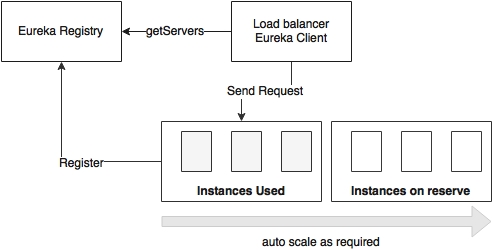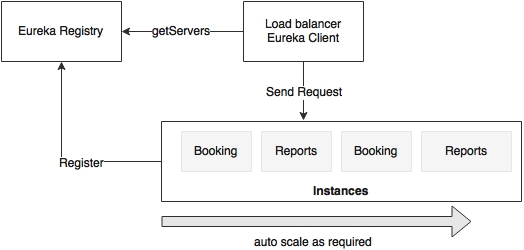Autoscaling is an approach to automatically scaling out instances based on the resource usage to meet the SLAs by replicating the services to be scaled.
The system automatically detects an increase in traffic, spins up additional instances, and makes them available for traffic handling. Similarly, when the traffic volumes go down, the system automatically detects and reduces the number of instances by taking active instances back from the service:

As shown in the preceding diagram, autoscaling is done, generally, using a set of reserve machines.
As many of the cloud subscriptions are based on a pay-as-you-go model, this is an essential capability when targeting cloud deployments. This approach is often called elasticity. It is also called dynamic resource provisioning and deprovisioning. Autoscaling is an effective approach specifically for microservices with varying traffic patterns. For example, an Accounting service would have high traffic during month ends and year ends. There is no point in permanently provisioning instances to handle these seasonal loads.
In the autoscaling approach, there is often a resource pool with a number of spare instances. Based on the demand, instances will be moved from the resource pool to the active state to meet the surplus demand. These instances are not pretagged for any particular microservices or prepackaged with any of the microservice binaries. In advanced deployments, the Spring Boot binaries are downloaded on demand from an artifact repository such as Nexus or Artifactory.
There are many benefits in implementing the autoscaling mechanism. In traditional deployments, administrators reserve a set of servers against each application. With autoscaling, this preallocation is no longer required. This prefixed server allocation may result in underutilized servers. In this case, idle servers cannot be utilized even when neighboring services struggle for additional resources.
With hundreds of microservice instances, preallocating a fixed number of servers to each of the microservices is not cost effective. A better approach is to reserve a number of server instances for a group of microservices without preallocating or tagging them against a microservice. Instead, based on the demand, a group of services can share a set of available resources. By doing so, microservices can be dynamically moved across the available server instances by optimally using the resources:

As shown in the preceding diagram, there are three instances of the M1 microservice, one instance of M2, and one instance of M3 up and running. There is another server kept unallocated. Based on the demand, the unallocated server can be used for any of the microservices: M1, M2, or M3. If M1 has more service requests, then the unallocated instance will be used for M1. When the service usage goes down, the server instance will be freed up and moved back to the pool. Later, if the M2 demand increases, the same server instance can be activated using M2.
Some of the key benefits of autoscaling are:
- It has high availability and is fault tolerant: As there are multiple service instances, even if one fails, another instance can take over and continue serving clients. This failover will be transparent to the consumers. If no other instance of this service is available, the autoscaling service will recognize this situation and bring up another server with the service instance. As the whole process of bringing up or bringing down instances is automatic, the overall availability of the services will be higher than the systems implemented without autoscaling. The systems without autoscaling require manual intervention to add or remove service instances, which will be hard to manage in large deployments.
For example, assume that two of instances of the Booking service are running. If there is an increase in the traffic flow, in a normal scenario, the existing instance might become overloaded. In most of the scenarios, the entire set of services will be jammed, resulting in service unavailability. In the case of autoscaling, a new Booking service instance can be brought up quickly. This will balance the load and ensure service availability.
- It increases scalability: One of the key benefits of autoscaling is horizontal scalability. Autoscaling allows us to selectively scale up or scale down services automatically based on traffic patterns.
- It has optimal usage and is cost saving: In a pay-as-you-go subscription model, billing is based on actual resource utilization. With the autoscaling approach, instances will be started and shut down based on the demand. Hence, resources are optimally utilized, thereby saving cost.
- It gives priority to certain services or group of services: With autoscaling, it is possible to give priority to certain critical transactions over low-value transactions. This will be done by removing an instance from a low-value service and reallocating it to a high-value service. This will also eliminate situations where a low-priority transaction heavily utilizes resources when high-value transactions are cramped up for resources.

For instance, the Booking and Reports services run with two instances, as shown in the preceding diagram. Let's assume that the Booking service is a revenue generation service and therefore has a higher value than the Reports service. If there are more demands for the Booking service, then one can set policies to take one Reports service out of the service and release this server for the Booking service.
Autoscaling can be applied at the application level or at the infrastructure level. In a nutshell, application scaling is scaling by replicating application binaries only, whereas infrastructure scaling is replicating the entire virtual machine, including application binaries.
In this scenario, scaling is done by replicating the microservices, not the underlying infrastructure, such as virtual machines. The assumption is that there is a pool of VMs or physical infrastructures available to scale up microservices. These VMs have the basic image fused with any dependencies, such as JRE. It is also assumed that microservices are homogeneous in nature. This gives flexibility in reusing the same virtual or physical machines for different services:

As shown in the preceding diagram, in scenario A, VM3 is used for Service 1, whereas in scenario B, the same VM3 is used for Service 2. In this case, we only swapped the application library and not the underlying infrastructure.
This approach gives faster instantiation as we are only handling the application binaries and not the underlying VMs. The switching is easier and faster as the binaries are smaller in size and there is no OS boot required either. However, the downside of this approach is that if certain microservices require OS-level tuning or use polyglot technologies, then dynamically swapping microservices will not be effective.
In contrast to the previous approach, in this case, the infrastructure is also provisioned automatically. In most cases, this will create a new VM on the fly or destroy the VMs based on the demand:

As shown in the preceding diagram, the reserve instances are created as VM images with predefined service instances. When there is demand for Service 1, VM3 is moved to an active state. When there is a demand for Service 2, VM4 is moved to the active state.
This approach is efficient if the applications depend upon the parameters and libraries at the infrastructure level, such as the operating system. Also, this approach is better for polyglot microservices. The downside is the heavy nature of VM images and the time required to spin up a new VM. Lightweight containers such as Dockers are preferred in such cases instead of traditional heavyweight virtual machines.
Elasticity or autoscaling is one of the fundamental features of most cloud providers. Cloud providers use infrastructure scaling patterns, as discussed in the previous section. These are typically based on a set of pooled machines.
For example, in AWS, these are based on introducing new EC2 instances with a predefined AMI. AWS supports autoscaling with the help of autoscaling groups. Each group is set with a minimum and maximum number of instances. AWS ensures that the instances are scaled on demand within these bounds. In case of predictable traffic patterns, provisioning can be configured based on timelines. AWS also provides ability for applications to customize autoscaling policies.
Microsoft Azure also supports autoscaling based on the utilization of resources such as the CPU, message queue length, and so on. IBM Bluemix supports autoscaling based on resources such as CPU usage.
Other PaaS platforms, such as CloudBees and OpenShift, also support autoscaling for Java applications. Pivotal Cloud Foundry supports autoscaling with the help of Pivotal Autoscale. Scaling policies are generally based on resource utilization, such as the CPU and memory thresholds.
There are components that run on top of the cloud and provide fine-grained controls to handle autoscaling. Netflix Fenzo, Eucalyptus, Boxfuse, and Mesosphere are some of the components in this category.
